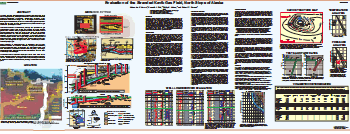
For lack of a transportation system, natural gas in northern Alaska is not currently
economic even though more than 30 trillion cubic feet are estimated to
occur in just two accumulations. Current interest and activity suggest
that within the next 10 years a natural gas pipeline could become a reality.
Such an eventuality would likely spur exploration for additional natural
gas reservoirs, particularly in the Brooks Range foothills, as well as
the re-evaluation and possible development of earlier gas discoveries,
such as the Kavik gas field.
The Kavik gas field was discovered in 1969 at the height of exploratory drilling
in the year following the discovery of the Prudhoe Bay oil field—the largest
oil accumulation in North America. The Kavik gas field is about 65 miles
southeast of Prudhoe Bay on an anticline in the foothills of the Brooks
Range, in the same Triassic reservoirs that host oil at Prudhoe Bay. Like
most hydrocarbon accumulations in the foothills, the Kavik accumulation
is a nonassociated gas field. Whereas most foothills gas accumulations
are poorly known because they are penetrated by just one well, and many
of those were discovered before modern well logs were available, the Kavik
gas field is unusual in that three wells delineate the field and all have
a complete suite of relatively modern logs that have been released to
the public. However, no estimate of the volume of gas in this accumulation
has been released. Because of current interest in a North Slope gas transportation
system and gas resources, we have assembled available data on the Kavik gas field and made an estimate of the volume of gas in this
accumulation.
This evaluation of the Kavik gas field's potential hydrocarbon reserves was presented
at a poster session of the Geological Society of America/American Association
of Petroleum Geologists conference held in San Jose, Calif., April 29
through May 1, 2005.
|

